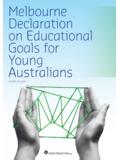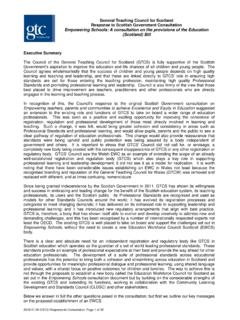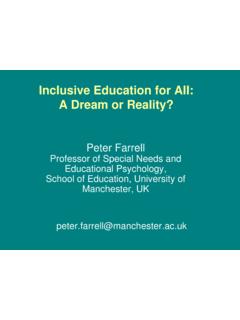Transcription of Special educational needs transition from school to ...
1 Special educational needs transition from school to further learningFinal reportMarch 2016 Crown copyright 2016 WG28209 Digital ISBN 978 1 4734 6013 3 Mae r ddogfen yma hefyd ar gael yn document is also available in Welsh. Special educational needs transition from school to further learningA report to identify what works and what improvements could be made to transition arrangements from school to post-16 further and higher education and training for young people with learning difficulties and/or authors: Dr Duncan Holtom, Dr Sarah Lloyd-Jones, Rhodri Bowen and Jack and Work UnitUnit 1 at LoudounPlas IonaButetown CardiffCF10 5 HWTel: 029 2048 8536 Further information Enquiries about this document should be directed to:Additional Learning needs BranchInfrastructure, Curriculum, Qualifications andLearner Support DirectorateWelsh GovernmentCathays ParkCardiffCF10 3 NQe-mail: Contents 1.
2 Introduction 3 2. Methodology 5 3. The transition planning process 10 4. Developing an inclusive transition planning process that enables informed decision making 15 5. Preparing young people, their parents/carers and settings for transition 27 6. Supporting learners progression following transition 36 7. Data: monitoring, evaluation and benchmarking 44 8. Conclusions 50 9. Bibliography 56 Appendix 1: Definitions 62 Appendix 2: Key features of effective practice 63 Figures Figure 1: transition planning as a process elements of effective practice 14 Tables Table 1: Number of stakeholders interviewed in each sector, service and learning setting 7 Table 2: Completion rates for students with a LDD enrolled at FE institutions compared with other students 47 Table 3: Key elements involved in developing person-centred transition planning processes 63 Table 4: Key elements involved in preparing young people, parents/carers and learning settings, providers and services for transition 67 Table 5: Key elements involved in ensuring young people s progression and achievement following transition 70 Table 6.
3 Improving data 72 3 1. Introduction Transitions for young people with Special educational needs , learning difficulties and/or disabilities The transition from school to further and higher education is a potentially difficult time for any young person but for those with Special educational needs (SEN) or learning difficulties and/or disabilities (LDD)1 there are often additional challenges related, for example, to challenges in coping with multiple changes in the services they rely on and in the people supporting and teaching them (NAFW, 2007, 2009; WG, 2010, 2013c). The aim and objectives of the study The aim of this study is to provide information on current arrangements across wales for the transition of young people with LDD from school to further education (FE), higher education (HE) and work-based learning (WBL), in order to identify what works and where improvements can be made.
4 The objectives of the study are to: consider how transition works in practice in each local authority (LA) in wales ; consider the extent to which agencies, including education, social services and health, engage early in the transition process; review background literature, including other countries experiences, National Assembly for wales Committee findings and outcomes from previous related initiatives, projects and task groups; identify case studies of good practice from across wales which are consistent with proposals for SEN reform; identify barriers, weaknesses or gaps in the way local arrangements for transition are made and propose cost-effective solutions which are consistent with proposals for SEN reform; and identify quantitative and qualitative measures which LAs and post-16 providers could use to benchmark their LDD transition arrangements.
5 1 The statutory definitions of SEN and LDD are similar and focus upon a child s or young person s learning difficulties or disabilities and the resultant need for Special provision to support their learning. Full details are included in Appendix 1. 4 Policy context The Special educational needs Code of Practice for wales (WAG, 2004a) covers transition planning for young people with SEN and is discussed further in section three. The Welsh Government is in the process of reforming the legislative framework for SEN. Proposals, which include the introduction of an integrated, collaborative process of assessment, planning and monitoring are outlined in the Draft Additional Learning needs and Education Tribunal (Bill).
6 This sets out the ambition of Welsh Government to secure improved long term outcomes for children and young people with SEN and ensure they realise their full potential. 5 2. Methodology This was primarily a qualitative study, focused upon exploring and understanding how, why, for whom, and under what circumstances, transition arrangements worked 2 or did not work (see HM Treasury, 2011; Pawson and Tilly, 1997). This approach was complemented by research to provide context (drawing principally upon secondary data) to enable broader judgments to be made about how widespread effective practice is. This section summarises the sources and methods used to collect data for the study and then discusses the strengths and limitations of the study.
7 Desk-based review of data Review of administrative data A desk-based review of young people s transitions from school and their experiences of FE was undertaken using data collected through the Careers wales destination survey3; the Pupil Level Annual school Census (PLASC)4; the Lifelong Learning wales Record (LLWR)5; the Learner Voice Survey (in further education)6; and the Higher Education Statistics Agency (HESA)7. 2 were effective, creating positive outcomes for young people and meaning stakeholders experiences were positive. 3 This was used to provide data on the destination of school leavers who have a statement and those who do not have a statement in years 12, 13 and 14. 4 This was used to provide data on the numbers of young people with SEN, and the type of SEN in schools.
8 5 This was used to provide data on completion rates for students with a LDD and without a LDD (self-declared) in FE institutions. 6 This was used to provide data on how young people who made the transition to FE rated their learning experience (Ipsos Mori, ). 7 This was used to provide completion rates for young people with a disability and without a disability who had made the transition to HE. 6 Literature reviews A literature review on effective practice in transition planning in the UK and selected OECD countries was undertaken. It searched eight online databases and, following a sift of studies for relevance and quality, identified 28 articles relevant to the study, which were reviewed. This literature review was complemented by a purposive review of recent studies in wales , including: reviews conducted by the Education and Lifelong Learning and Skills Committee (ELLS) (NAFW, 2007); the Education and Learning Committee (NAFW, 2009); and the Post-16 Additional Learning needs Funding Task and Finish Group (WG, 2010); and research into Post-19 Education Provision for Young People with Complex Learning Difficulties (WG, 2013a); the Youth Engagement and Progression Framework (YEPF) (WG, 2014b); Additional Learning needs (ALN) Pilots (WG, 2013b); and transition Key Worker Pilots (WG, 2013c8).
9 Review of transition policies A desk-based review of transition policies of all 22 LAs9 and of 12 FE colleges in wales was undertaken. Fieldwork (interviews with stakeholders) Most of the stakeholders who contributed to the study were identified through research with 14 LA transition services and nine area-based case studies, in south east, south west, mid and north wales . These provided a focus for interviews with: learning settings including mainstream and Special schools, FE colleges, WBL providers and universities; services involved in transition planning, such as Careers wales , social services, health and education services and voluntary organisations; and young people and their parents and carers who were preparing for, or who had made, transitions from school to college.
10 In total, 91 stakeholders (including interviews with six young people with LDD and five parents or carers) were undertaken using a mix of face-to-face and 8 9 Blaenau Gwent, Monmouthshire, Newport and Torfaen share a pan-Gwent policy. Conwy and Denbighshire also share a policy. 7 telephone interviews. Table 1 summarises the profile of those who participated in the study. The transition services and schools where stakeholders were interviewed were drawn from 17 of the 22 LAs10 in wales . Table 1: Number of stakeholders interviewed in each sector, service and learning setting Sector No. Welsh Government 6 Voluntary 5 Services No. transition services* 23 Careers wales 6 Local Health Boards 2 Learning settings No.














